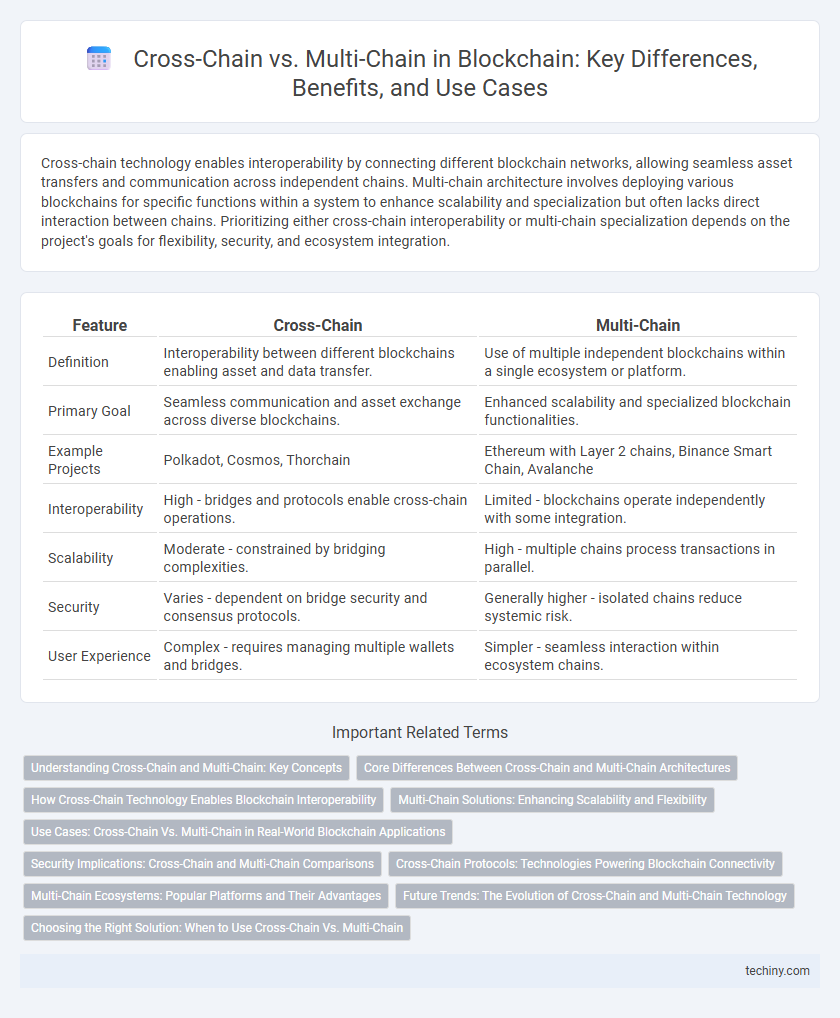Cross-chain technology enables interoperability by connecting different blockchain networks, allowing seamless asset transfers and communication across independent chains. Multi-chain architecture involves deploying various blockchains for specific functions within a system to enhance scalability and specialization but often lacks direct interaction between chains. Prioritizing either cross-chain interoperability or multi-chain specialization depends on the project's goals for flexibility, security, and ecosystem integration.
Table of Comparison
| Feature | Cross-Chain | Multi-Chain |
|---|---|---|
| Definition | Interoperability between different blockchains enabling asset and data transfer. | Use of multiple independent blockchains within a single ecosystem or platform. |
| Primary Goal | Seamless communication and asset exchange across diverse blockchains. | Enhanced scalability and specialized blockchain functionalities. |
| Example Projects | Polkadot, Cosmos, Thorchain | Ethereum with Layer 2 chains, Binance Smart Chain, Avalanche |
| Interoperability | High - bridges and protocols enable cross-chain operations. | Limited - blockchains operate independently with some integration. |
| Scalability | Moderate - constrained by bridging complexities. | High - multiple chains process transactions in parallel. |
| Security | Varies - dependent on bridge security and consensus protocols. | Generally higher - isolated chains reduce systemic risk. |
| User Experience | Complex - requires managing multiple wallets and bridges. | Simpler - seamless interaction within ecosystem chains. |
Understanding Cross-Chain and Multi-Chain: Key Concepts
Cross-chain technology enables interoperability between different blockchain networks by facilitating asset transfers and data sharing across independent chains, enhancing liquidity and collaboration. Multi-chain refers to the simultaneous use of multiple distinct blockchains within an ecosystem, allowing tailored solutions for various applications while maintaining separate consensus mechanisms. Understanding these concepts is crucial for developing scalable, flexible blockchain architectures that leverage diverse network strengths.
Core Differences Between Cross-Chain and Multi-Chain Architectures
Cross-chain architecture enables interoperability by facilitating communication and asset transfers between distinct blockchain networks, supporting decentralized applications across different chains. Multi-chain architecture involves deploying multiple, independent blockchains within a single ecosystem to enhance scalability, customization, and performance without requiring cross-network interactions. Core differences include cross-chain's emphasis on bridging separate blockchains versus multi-chain's approach of parallel chains operating under a unified governance or protocol framework.
How Cross-Chain Technology Enables Blockchain Interoperability
Cross-chain technology enables blockchain interoperability by facilitating seamless data and asset transfers between distinct blockchain networks, overcoming isolated ledgers and fragmented ecosystems. By utilizing protocols like atomic swaps, hashed time-lock contracts (HTLC), and interoperability bridges, cross-chain systems maintain security and decentralization while allowing diverse blockchains to communicate and exchange value directly. This capability expands blockchain functionality, promotes liquidity across platforms, and supports complex decentralized applications that rely on multi-chain resources.
Multi-Chain Solutions: Enhancing Scalability and Flexibility
Multi-chain solutions enhance scalability by enabling parallel processing across multiple independent blockchains, reducing congestion and improving transaction throughput. They offer flexibility by supporting diverse protocols and assets, allowing seamless interoperability without compromising security. Leveraging multi-chain architectures empowers decentralized applications to optimize performance and expand functionality across various blockchain networks.
Use Cases: Cross-Chain Vs. Multi-Chain in Real-World Blockchain Applications
Cross-chain solutions enable interoperability by facilitating asset transfers and data exchange between different blockchain networks, crucial for decentralized finance (DeFi) and cross-platform dApps. Multi-chain ecosystems operate multiple independent blockchains to optimize scalability, security, and specialized use cases within a cohesive infrastructure, often used by enterprises and large-scale protocols. Use cases for cross-chain include seamless token swaps and liquidity sharing, while multi-chain focuses on parallel processing and governance customization across various blockchains.
Security Implications: Cross-Chain and Multi-Chain Comparisons
Cross-chain protocols facilitate asset transfers across different blockchains, exposing transactions to increased security risks such as smart contract vulnerabilities and bridge exploits. Multi-chain architectures maintain separate blockchains with distinct consensus mechanisms, reducing the attack surface but potentially increasing complexity in coordination and interoperability. Security implications favor multi-chain systems for isolated risk management, whereas cross-chain solutions require robust verification methods to prevent cross-chain fraud and double-spending.
Cross-Chain Protocols: Technologies Powering Blockchain Connectivity
Cross-chain protocols enable seamless interoperability between distinct blockchain networks by facilitating the transfer of assets and data without intermediaries, using technologies such as atomic swaps, hash time-locked contracts (HTLCs), and relay chains. These protocols enhance decentralized finance (DeFi) ecosystems by allowing smart contracts on different chains to interact securely and efficiently. Projects like Polkadot, Cosmos, and Thorchain exemplify cutting-edge implementations of cross-chain interoperability, driving wide adoption and expanding blockchain connectivity.
Multi-Chain Ecosystems: Popular Platforms and Their Advantages
Multi-chain ecosystems leverage multiple interconnected blockchains to enhance scalability, interoperability, and security. Popular platforms such as Polkadot, Cosmos, and Avalanche provide robust frameworks enabling seamless asset transfers and decentralized application (dApp) deployment across diverse blockchain networks. Their advantages include reduced congestion, improved transaction speeds, and expanded developer flexibility, fostering a more resilient and versatile blockchain environment.
Future Trends: The Evolution of Cross-Chain and Multi-Chain Technology
Future trends in blockchain emphasize the integration of advanced interoperability protocols to enhance cross-chain and multi-chain functionalities, enabling seamless asset transfers and data exchanges across diverse decentralized networks. Innovations like layer-zero solutions and blockchain bridges are accelerating the evolution toward a more connected ecosystem, reducing fragmentation and boosting scalability. Enhanced security frameworks and decentralized governance models are set to support these developments, promoting robust, efficient, and user-friendly cross-chain and multi-chain applications.
Choosing the Right Solution: When to Use Cross-Chain Vs. Multi-Chain
Cross-chain solutions enable seamless interoperability between distinct blockchain networks, ideal for users needing asset transfers and data exchange across different protocols. Multi-chain frameworks support simultaneous operations within multiple blockchains managed under a unified ecosystem, suited for projects prioritizing scalability and diversified application deployment. Selecting cross-chain is optimal for integrating independent chains, whereas multi-chain best suits organizations seeking cohesive control over various interconnected networks.
Cross-chain vs Multi-chain Infographic

 techiny.com
techiny.com